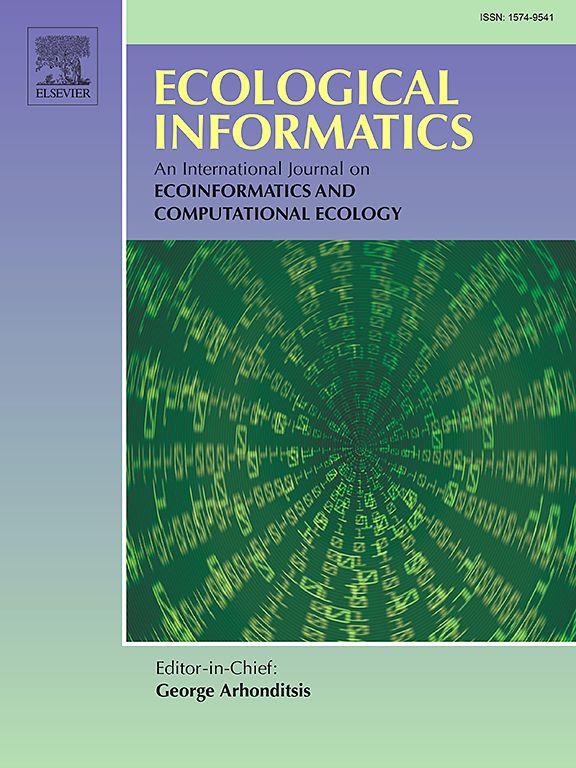Simplifying the calibration of ecological models by using the parameter estimation tool (PEST): The Curonian Lagoon case
IF 5.8
2区 环境科学与生态学
Q1 ECOLOGY
引用次数: 0
Abstract
In this study, we implemented an automated calibration procedure for an ecological model of the Curonian Lagoon, supported by a comprehensive two-year field observation dataset. Data from the second-year were used for model calibration, while first-year observations served for the validation of the model's performance in simulating nutrient dynamics. Calibration is essential for improving the accuracy and reliability of process-based ecological models. However, subjective and time-consuming manual (trial-and-error) calibration methods cannot ensure optimal parameter match.
To address this, we automated the calibration of a newly developed ecological model to improve the simulation of nutrient dynamics as ammonia, nitrate, and phosphate in the estuarine system (Curonian Lagoon). Calibration was carried out using Parameter Estimation (PEST) and PEST++ tools, focusing on three aforementioned limiting nutrient forms. We applied the method of Morris for global sensitivity analysis to determine the key parameters influencing model behavior. As biogeochemical models are highly nonlinear and multimodal, global methods are often assumed to provide a better fit. However, we challenged this assumption by initiating the inverse problem at different locations in the parameter space using a robust variant of a gradient-based method, which ultimately resulted in a better fit than global methods.
We tested four different optimization algorithms available in the PEST and PEST++ suites. The results demonstrated that PEST significantly improved model calibration performance followed the nutrient dynamics more effectively than more complex biogeochemical models for the Curonian Lagoon, and outperformed manual calibration methods. Furthermore, we employed an ensemble-based method within the PEST++ suite for parameter estimation and uncertainty quantification, significantly reducing the computational burden of these analyses.

使用参数估计工具(PEST)简化生态模型的校准:库尔潟湖案例
在这项研究中,我们实施了一个库尔斯泻湖生态模型的自动校准程序,该模型由一个全面的两年野外观测数据集支持。第二年的数据用于模型校准,而第一年的观测数据用于验证模型在模拟养分动态方面的性能。校准对于提高基于过程的生态模型的准确性和可靠性至关重要。然而,主观且耗时的手动(试错)校准方法无法保证参数的最佳匹配。为了解决这个问题,我们自动校准了一个新开发的生态模型,以改善河口系统(库尔斯泻湖)中氨、硝酸盐和磷酸盐等营养动态的模拟。使用参数估计(PEST)和PEST++工具进行校准,重点关注上述三种限制营养形式。我们采用Morris方法进行全局敏感性分析,以确定影响模型行为的关键参数。由于生物地球化学模型是高度非线性和多模态的,因此通常认为全局方法提供了更好的拟合。然而,我们挑战了这一假设,通过使用基于梯度的方法的鲁棒变体在参数空间的不同位置初始化逆问题,最终导致比全局方法更好的拟合。我们测试了PEST和pest++套件中可用的四种不同的优化算法。结果表明,与更复杂的库尔湖生物地球化学模型相比,PEST显著提高了模型的校准性能,更有效地跟踪了营养动态,优于人工校准方法。此外,我们在PEST++套件中采用了基于集成的方法进行参数估计和不确定性量化,大大减少了这些分析的计算负担。
本文章由计算机程序翻译,如有差异,请以英文原文为准。
求助全文
约1分钟内获得全文
求助全文
来源期刊

Ecological Informatics
环境科学-生态学
CiteScore
8.30
自引率
11.80%
发文量
346
审稿时长
46 days
期刊介绍:
The journal Ecological Informatics is devoted to the publication of high quality, peer-reviewed articles on all aspects of computational ecology, data science and biogeography. The scope of the journal takes into account the data-intensive nature of ecology, the growing capacity of information technology to access, harness and leverage complex data as well as the critical need for informing sustainable management in view of global environmental and climate change.
The nature of the journal is interdisciplinary at the crossover between ecology and informatics. It focuses on novel concepts and techniques for image- and genome-based monitoring and interpretation, sensor- and multimedia-based data acquisition, internet-based data archiving and sharing, data assimilation, modelling and prediction of ecological data.
 求助内容:
求助内容: 应助结果提醒方式:
应助结果提醒方式:


